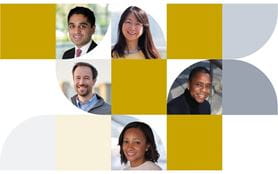Real change to virtual working
Related people
Headlines in this article
Related news and insights
Publications: 11 December 2023
Publications: 11 December 2023
Publications: 11 December 2023
Publications: 11 December 2023
Responsible AI: navigating the risks and embracing the possibilities
The global onset of Covid-19 unlocked rapid momentum for change at Allen & Overy that looks set to transform the firm over the next decade.

There’s nothing virtual about the disruption caused by the Covid-19 pandemic. At A&O, the crisis ushered in what is likely to be one of the most rapid periods of change since the firm was founded in 1930.
A crisis like no other, Covid-19 forced law firms to abruptly change how they worked if they intended to continue doing business.
Yet it also sowed the seeds of a longer-term shift in working practices for a profession that is reliant on collaboration between teams of lawyers working together in offices, hastening the adoption of essential enabling technologies and calling for a culture that fosters greater flexibility.
“This is about so much more than virtual meetings and being able to access systems remotely,” says Jonathan Brayne, an A&O partner and chair of Fuse, who specialises in innovation and business model change.
By an extraordinary and fortunate coincidence, A&O had reached the final stage of a large technology overhaul designed to enable staff to work remotely, accessing their documents securely on a laptop irrespective of where they were working.
“There are long-term trends that we were already actively pursuing in A&O that I think will gain momentum due to Covid-19,” said Jonathan. “They will have a substantial effect on how lawyers work, not just in terms of working away from the office.”
Preparing for lockdown
Ahead of lockdown being announced in the UK on 16 March 2020, A&O’s IT team had a frantic weekend implementing a new document management system and a myriad of other changes. The culmination of more than two years’ work, this technology overhaul fortuitously made it easier for staff to work from home for the foreseeable future.
To varying degrees, the firm’s other offices, from Asia to Europe and the Americas, had similar experiences. With a determined effort, the IT team stretched a computer network spanning more than 40 offices to include the homes of about 5,500 staff around the world, turning a physical firm into a virtual one. People quickly adapted, finding new ways to collaborate while showing great empathy towards colleagues.
This bolt from the blue has raised three key questions: How will technology change how lawyers work in future? How much office space will be needed? What kind of culture and skills will the firm require?
In the space of 48 hours, we turned a physical law firm into a virtual law firm.
The inside story
When governments around the world locked down countries in the first months of 2020, the crisis was unlike anything that we’d planned for. Business continuity plans had to be ripped up. It was a race against time to get everyone equipped to work and speak to clients from home, while also continuing to deliver essential services such as processing voluminous legal documents.
In the words of John O’Donovan, Chief Technology Officer, it was “quite a determined effort”.
“There was a lot of planning and a lot of thinking about how do we make sure that we can keep the capacity there for the people who need it the most,” he said. “In the space of 48 hours, we turned a physical law firm into a virtual law firm. These are a couple of days of my life I would happily not live again.”
The rollout was phased in across different regions. In London, it was scheduled for the weekend before lockdown. It went smoothly, providing the perfect technology infrastructure for working from home.
There were inevitably stop-gap measures to start with. While laptops had been provided to most lawyers, A&O’s Technology board quickly agreed to provide laptops for all staff who did not already have one, ordering more than 2,000 globally.
However, sourcing so many laptops quickly was a logistical problem, especially as the spike in demand coincided with a cut in output from semiconductor chip fabrication plants because of the impact of Covid-19.
To bridge the gap until suitable laptops could be found, the London office bought 500 Chromebooks, which could be linked up to desk computers in the office.
“In Madrid, all IT office equipment was sent to people’s homes and across the rest of Europe we arranged for people to get their new home working equipment delivered by taxi or courier,” says Andrew Brammer, IT and Shared Services Director.
This all led to a swift transformation in how people communicated. In-person meetings and phone calls were replaced by video conference calls. However, the switch created some practical challenges. The surge in telecoms traffic globally – a ‘perfect storm’ of conference calls, home-schooling of children and other heightened home internet usage – led to broadband networks crashing.
In a profession like law being so dependent on teamwork, reproducing the collaborative nature of an office digitally was also a challenge. In the months following the initial lockdown, the firm adopted a range of cloudbased technologies, including Microsoft Teams, Zoom, DocuSign (electronic signatures) and OneDrive.
“There’s definitely been an acceleration in the technical literacy of the firm,” says Andrew. “We’ve definitely moved quickly to take products that otherwise would’ve taken a lot longer to push into the business. It’s been fascinating to watch how this event has made many things possible that would’ve taken much longer in normal circumstances.”
The IT department worked tirelessly to help people make the transition from the office to home working and, at the same time, learn to use new tools. Thousands of hours of virtual training, genius bars and one-to-one training were delivered; at times the team made classes available 24 hours a day, seven days a week. The service desk dealt with more than 14,000 calls in just a few weeks.
The U.S. Research & Library departments converted print publications to online format, allowing staff access to materials 24/7, while also saving on paper and printing.
Additionally, the Document Services teams adapted quickly to providing their services remotely to support the lawyers working from home. That included logistical challenges such as how to move the huge printed documents that lawyers traditionally mark up between the print room and lawyers’ homes, how to get mark-ups back to document production, and how to deliver mail and packages to and from the lawyers. It required some of the Mailroom team to come into the office throughout lockdown.
Illustrating the size of the challenge, the UK firm alone was hiring 750 to 1,000 extra couriers a month to deliver printed documents to its lawyers and their clients. In Belgium, an additional 800 couriers were hired to deliver printed matters as well as IT equipment to people’s homes.

Supporting our people
Beyond the immediate practical implications of the crisis, A&O moved quickly to help staff adjust to the personal difficulties of working from home. Once people were at home, HR focused on supporting both their general wellbeing and, more specifically, emotional welfare. The frequency of internal communications, including office updates, online resources and inspiring personal stories from colleagues, increased.
For trainees, the crisis was especially disappointing. In the London office, for instance, the March 2020 intake was in the office for only five days. These trainees subsequently received tailored remote training and development, although it remains hard to replicate the benefit of learning from working closely with more experienced lawyers.
Another obstacle was the staff for whom home was on the other side of the world. Moving them back was not as straightforward as buying a plane ticket. The Regulatory, Tax, HR and Travel teams joined forces by “rolling up their sleeves and finding solutions”, says Sasha Hardman, Global HR Director.
Perhaps one of the most impressive things, though, was how the crisis brought out the best of the A&O culture. “Our culture of being supportive of each other has come to the fore in terms of people being caring and mindful of their colleagues,” says Sasha. “There are stories of people who knew somebody was in a flat on their own and so they have jogged past their homes just to wave through the window. There have been many virtual cups of tea, people calling each other and all sorts of things were going on to make people feel part of their A&O family, wherever that may be.”
Managing a hybrid workplace
As the first wave of the pandemic ebbed, people returned to A&O’s offices to different degrees in different regions, depending on the local transport network, health situation and government guidance. London and New York were the last to reopen. Yet as a second wave developed in many countries, staff in some cities had to move back to their home offices, depending on the guidance in that location.
While the details differ between cities, the firm continues to take all necessary measures to ensure social distancing. In London, for instance, the firm is a Covid-19 secure location, with strict protocols about how different rooms such as the mailroom are used. Only one person is allowed to work in an office on any one day, and there are limits on the number of people allowed in communal areas. Additionally, offices continue to take steps to make sure that they maintain social distancing.
In Belfast, home to A&O’s second largest office, agile working was introduced in 2019 as part of the refit of the building, making it especially well prepared.
The result? Fewer people, fewer desks and everyone has a laptop. “Belfast was the first big introduction of agile working,” explains Andrew. “So, on the day that we were told that we had to work from home, we were already prepared. It was the easiest A&O office to sort out because everybody was already used to that way of working.”
The extended period of the hybrid workplace has required the firm to be nimble, as countries have reacted to spikes in the virus by ratcheting restrictions on social interaction up and down. Additionally, as time went on, so the firm became more mindful of the effect on staff morale, wellbeing and learning, supporting people who wanted to return to the office as restrictions began to ease.
A lesson of the lockdown is that remote working can be successful, leading logically to a rethink of the purpose of the office. In fact, the early results of a recent survey indicate a large percentage of our people felt they were more productive, according to Edward Mackaness, Associate Director, Business Services. “With office utilisation set to be lower in the future, it begs the question whether we all need to have our dedicated desks in the future,” he said. “Instead, teams may have a dedicated area allocated to them and they can choose who they want to work with and how they want to use that space themselves.”
There’s definitely been an acceleration in the technical literacy of the firm... It’s been fascinating to watch how this event has made many things possible that would’ve taken much longer in normal circumstances.
The future of the office
Looking to the future, there is little doubt that Covid-19 has jolted A&O into accelerated transformation. As with other businesses, many of the changes were already under way, albeit at a slower pace. The challenge? Making sure that the office of the future retains the best of the physical and remote worlds.
Turning first to the physical office, the firm’s leadership has stated that presenteeism is in the past. Individuals will be given more flexibility to decide how to split their time between working from home and the office.
Wim Dejonghe, Senior Partner, says offices may well become meeting places for team activities such as opportunities to collaborate and generate new ideas rather than day-to-day workspaces. However, he cautions that young people in the early stages of their careers will need them more, as they seek to build professional networks and learn from their peers.
Ambitious targets have been set to reduce A&O’s office property portfolio over the next ten years. Even before Covid-19, the average office occupancy was low. A recent study estimated that utilisation in the London office averaged about 55%. If people work from the office for only three days a week in future, then that might fall to about 35%. It’s not hard to see how great the potential is for savings across the portfolio.
There are other savings besides – both financial and environmental. For instance, in the four months from April to July, the UK offices saved about 51 tonnes of printing paper, and in the seven months from March to October, the New York and Washington D.C. offices reduced office supplies by 75% and 50% respectively. Additionally, business travel and in-person events – non-existent as 2020 ended – have been replaced with video conferences and webinars.
By demystifying technology, the events of 2020 have paved the way for a real conversation about how lawyers work. We are seeing an uptick in the use of legal technology to extract data from documents, speed up the review process and automate content creation – all of which helps to increase speed and efficiency while reducing the cost to clients. In future, technology could be used to answer frequently asked questions, as well as to retrieve and push relevant precedents and knowledge to lawyers seamlessly as they work, so reducing research time, while streamlining deal and dispute processes.
“Any law firm that aspires to be global and also local around the world, which is what we aspire to be, will need these tools, in my view,” says Jonathan. “Even the high-end Wall Street M&A law firms may have to find a way to respond to this.”
Yet perhaps one of the biggest lessons of the pandemic for A&O is the importance of a culture that is open to change. Having a more diverse and inclusive workforce is essential for building a flexible culture. Recruiting from a more diverse group of people may also help the firm to access the wider range of skills it will need, especially related to technology.
“Innovation requires skill sets that aren’t necessarily present in your organisation, and that may require recruiting from a wider pool of people,” explains Jonathan. “Also, in order to change you have to be open to change. Diversity encourages a mindset of being open to anything new. You find much less of a visceral ‘no’ coming out of a diverse group of people.”
It seems likely that 2020 will prove an historic year for A&O. Out of the disruption and tragedy of the pandemic has come a sense of optimism about a new momentum and appetite for change. What appears certain is that by the firm’s centenary, in 2030, its ways of working will be very different from how they were in 2019.

Download the yearbook
Read our full Alumni Yearbook 2020
Download PDF





